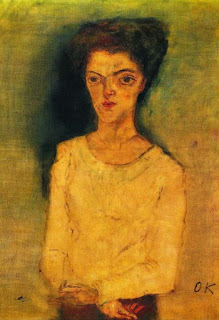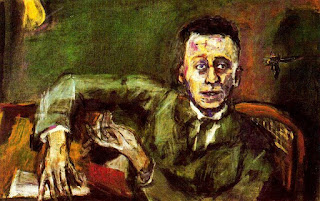Adolf Loos's love affair with "Amerika" is well documented but very little is known of the 17 portraits he commissioned over the years from his very close friend Oskar Kokoschka and loaned to the art exhibition on display in Bernard Maybeck's Palace of Fine Arts at the Panama-Pacific Exposition throughout 1915 (see below for example). I have not yet determined how Loos became involved with the Exposition's art exhibition but I serendipitously learned of his loan of the Kokoschka portraits while trying to determine if he had ever visited San Francisco. Performing an "Adolf Loos San Francisco" Google search immediately turned up the exhibition catalog referencing his Koschka loan. (Moore, Charles, Official Catalog of Exhibitors, Panama-Pacific International Exposition, San Francisco, California, 1915, pp. 65-66).
(Click on images to enlarge)
Adolf Loos, 1909. Oskar Kokoschka
Oskar Koschka, ca. 1909. From Universitat fur angewandte Kunst, Vienna via The Looshaus by Christopher Long, Yale University Press, 2011, p. 55.
Palace of Fine Arts, Panama Pacific International Exposition, 1915. Bernard Maybeck, architect. Photo by R. M. Schindler, fall 1915. Courtesy UC Santa Barbara Art Museum, Architecture and Design Collections, Schindler Collection.
Loos made a formative sojourn to the U.S.A. between 1893 and 1896 but I could find no mention of San Francisco being part of his itinerary during his stay. If he had visited the West Coast he would certainly have been struck, as I was, by A. C. Schweinfurth's 1896 Hearst Building, home of the San Francisco Examiner, and M. H. de Young's Chonicle Building across the street completed by Burnham & Root in 1889. He would already have been well versed in the Chicago-based firm's work and would have noted its structural similarities with the Monadnock Building. Upon completion of the nearby Spreckels Call Building in 1898 the complex intersection of Third, Market, Geary and Kearney Streets became known as "Newspaper Angle" (see below).
The intersection of 3rd, Market, Geary and Market Streets aka "Newspaper Angle," downtown San Francisco. From Google Maps.
Hearst Building, 1896. A. C. Schweinfurth, architect. "The Later Work of A. C. Schweinfurth, 1864-1900," Architectural Review, March 1902, p. 81.
If he did not make it to San Francisco Loos possibly would have run across photos of A. C. Scweinfurth's design which appeared in the Architectural Review in 1902 (see above). Schweinfurth also made a two-year European visit between 1898 and 1900 and perhaps crossed paths with Loos at some point. Preceding his Goldman and Salatsch Building design by 15 years, Schweinfurth's "Newspaper Angle" structure bears striking similarities, both in facade and hexagonal lot configuration, to Loos's 1911 Michaelerplatz edifice.
Goldman and Salatsch Building, aka "Looshaus" nearing completion, Michaelerplatz, Vienna, 1911. From Long, p. 118.
Michaelerplatz, Vienna, Austria. From Google Maps.
San Francisco Chronicle Building, 1889. Burnham and Root, architects.
Preceding Schweinfurth's Hearst Building on "Newspaper Angle" was M. H. de Young's San Francisco Chronicle Building completed by Chicago architects Burnham and Root in 1889 (see above). The building was San Francisco's first skyscraper at a height of 160 ft. Daniel Burnham also had visions of erecting a much taller building than Schweinfurth's on the Hearst property but it did not come to pass (see below). (John Wellborn Root, Architect by Harriet Monroe, Prairie School Press, 1966, p. 148).
San Francisco Examiner Building (project), Burnham and Root, architects. (Ibid, p. 138).
Filling out the "Angle" was the 1898 San Francisco Call Building (see below) designed by the Reid Brothers, formerly of San Diego. After first designing for the Spreckels the
Hotel del Coronado in San Diego, the Reid Brothers had essentially become their family architects after their 1892-3 move to San Francisco. Here they also designed for the Spreckels several mansions, the
Spreckels Car House and the 1899
Spreckels Music Concourse in Golden Gate Park which presaged the
Spreckels Organ Pavilion for the 1915 Panama-California Exposition. The 315 ft. high steel-framed Call Building was for years the tallest
building west of Chicago, almost doubling the height of Burnham & Root’s Chronicle Building.
(Author's note: After the Reid Brothers moved to San Francisco ca. 1892-3, soon-to-be Irving Gill partner William S. Hebbard took over their remaining San Diego projects. Coincidentally Hebbard also apprenticed for two years with Burnham and Root in upon his graduation from Cornell in 1887.).

San Francisco Call Building, Reid Brothers, architects, 1898.
Palace of Fine Arts, Panama Pacific International Exposition, 1915. Bernard Maybeck, architect. Photo by R. M. Schindler, fall 1915. Courtesy UC Santa Barbara Art Museum, Architecture and Design Collections, Schindler Collection.
Besides his own portrait seen at the beginning of this article, other known portraits in the Palace of Fine Arts (see above) exhibition included his and Kokoschka's very close mutual friends Karl Kraus, Egon Wellesz, and Peter Altenberg. The catalog identified the other portraits only as Mr. X no.s 1-13. One can make educated guesses as to whom some of the others might have been from various Loos biographies such as Christopher Long's The Looshaus which delves into Loos's lifelong patronage of Kokoschka. In fact Loos most likely commissioned most, if not all, of the portraits for this important exhibition, the first to include Kokoschka and this sort of Expressionistic work on the West Coast.
Karl Kraus, Oskar Kokoschka.
Egon Wellesz, 1909. Oskar Kokoschka.
Peter Altenberg, 1909. Oskar Kokoschka.
R. M. Schindler, untitled, Schindler Papers, UC-Santa Barbara via The Blue Four Collection at the Norton Simon Museum, edited by Vivian Endicott Barnett, Yale University Press, 2002, p. 471.
Schindler was certainly inspired by Kokoschka, Egon Schiele and others in their Secessionist circles evidenced by what remains of his own drawings in his papers at UC-Santa Barbara and the Galka Scheyer Collection (see above and below for example).
R. M. Schindler, "Trickling Hands," 1914-17. Gift of the artist to Galka Scheyer, 1927. From Barnett, p. 471.
The 1922 Chicago Tribune Tower competition was also being closely followed by Schindler and fellow Loos protege Richard Neutra. They would have gotten the likely joke intended by Loos over his entry based upon their knowledge of Loos's idol Louis Sullivan's loathing of the Doric column. (For much more on this see my "R. M. Schindler, Richard Neutra and Louis Sullivan's"Kindergarten Chats").
This piece is just a placeholder for a much more in-depth essay which I hope evolves as I learn more through future research. As always I would greatly appreciate any feedback and leads to help expand this article. I will be posting new material as I uncover it so stay tuned.










































